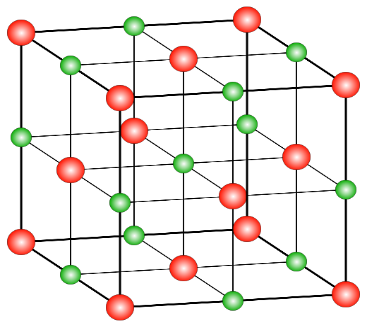Answer
396.9k+ views
Hint: We need to know some properties of solid state and accordingly define crystal lattice and unit cell and distinguish between the two. Solids are a type of matter and have a definite mass, shape and volume. Their constituent particles (atoms, molecules or ions) have a fixed arrangement and order. Depending on the nature of order they are classified as crystalline or amorphous. The terms Crystal lattice and unit cell are restricted to crystalline solids only.
Complete answer:
We have to know that the crystalline solids have a definite characteristic geometrical shape due to a large number of small crystals present which also have a definite shape and order. There exists a regular pattern of arrangement of particles which repeats itself periodically over the entire crystal. Sodium chloride is an example of crystalline solid.
Let’s we discuss about the crystal lattice as,
-Crystal lattice: The main characteristic of crystalline solids is a regular and repeating pattern of constituent particles. If the three dimensional arrangement of constituent particles in a crystal is represented diagrammatically, in which each particle is depicted as a point, the arrangement is called crystal lattice. A portion of crystal lattice of sodium chloride is given below:

The red and green points in the image above represent the sodium and chloride ions. Hence it can be said that a regular three dimensional arrangement of points in space is known as crystal lattice and each point in a lattice is called a lattice point or lattice site which represents one constituent particle.
-Unit cell: In a crystal lattice, the smallest portion which when repeated in different directions generates the entire lattice is called the unit cell. The dimensions of a unit cell with respect to its constituents are mutually perpendicular and characterized by six sides or parameters as shown in the image above.
Note:
We must know that the crystal lattices are available in 14 different possible three dimensional lattices called Bravais Lattices. Unit cells are divided into two categories – primitive and centered unit cells. When the constituent particles are present only on the corner positions then it is called a primitive unit cell. The example given above is an example of primitive type. When one or more constituent particles are present in other positions in addition to those at corners are called centered unit cells.
Complete answer:
We have to know that the crystalline solids have a definite characteristic geometrical shape due to a large number of small crystals present which also have a definite shape and order. There exists a regular pattern of arrangement of particles which repeats itself periodically over the entire crystal. Sodium chloride is an example of crystalline solid.
Let’s we discuss about the crystal lattice as,
-Crystal lattice: The main characteristic of crystalline solids is a regular and repeating pattern of constituent particles. If the three dimensional arrangement of constituent particles in a crystal is represented diagrammatically, in which each particle is depicted as a point, the arrangement is called crystal lattice. A portion of crystal lattice of sodium chloride is given below:

The red and green points in the image above represent the sodium and chloride ions. Hence it can be said that a regular three dimensional arrangement of points in space is known as crystal lattice and each point in a lattice is called a lattice point or lattice site which represents one constituent particle.
-Unit cell: In a crystal lattice, the smallest portion which when repeated in different directions generates the entire lattice is called the unit cell. The dimensions of a unit cell with respect to its constituents are mutually perpendicular and characterized by six sides or parameters as shown in the image above.
Note:
We must know that the crystal lattices are available in 14 different possible three dimensional lattices called Bravais Lattices. Unit cells are divided into two categories – primitive and centered unit cells. When the constituent particles are present only on the corner positions then it is called a primitive unit cell. The example given above is an example of primitive type. When one or more constituent particles are present in other positions in addition to those at corners are called centered unit cells.
Recently Updated Pages
How many sigma and pi bonds are present in HCequiv class 11 chemistry CBSE

Why Are Noble Gases NonReactive class 11 chemistry CBSE

Let X and Y be the sets of all positive divisors of class 11 maths CBSE

Let x and y be 2 real numbers which satisfy the equations class 11 maths CBSE

Let x 4log 2sqrt 9k 1 + 7 and y dfrac132log 2sqrt5 class 11 maths CBSE

Let x22ax+b20 and x22bx+a20 be two equations Then the class 11 maths CBSE

Trending doubts
Fill the blanks with the suitable prepositions 1 The class 9 english CBSE

At which age domestication of animals started A Neolithic class 11 social science CBSE

Which are the Top 10 Largest Countries of the World?

Give 10 examples for herbs , shrubs , climbers , creepers

Difference between Prokaryotic cell and Eukaryotic class 11 biology CBSE

Difference Between Plant Cell and Animal Cell

Write a letter to the principal requesting him to grant class 10 english CBSE

Change the following sentences into negative and interrogative class 10 english CBSE

Fill in the blanks A 1 lakh ten thousand B 1 million class 9 maths CBSE



